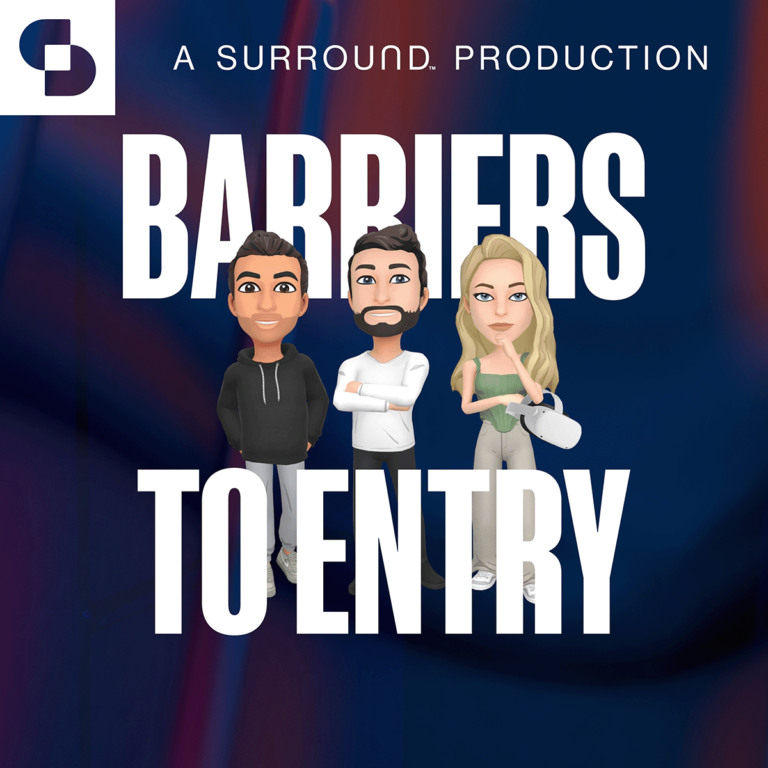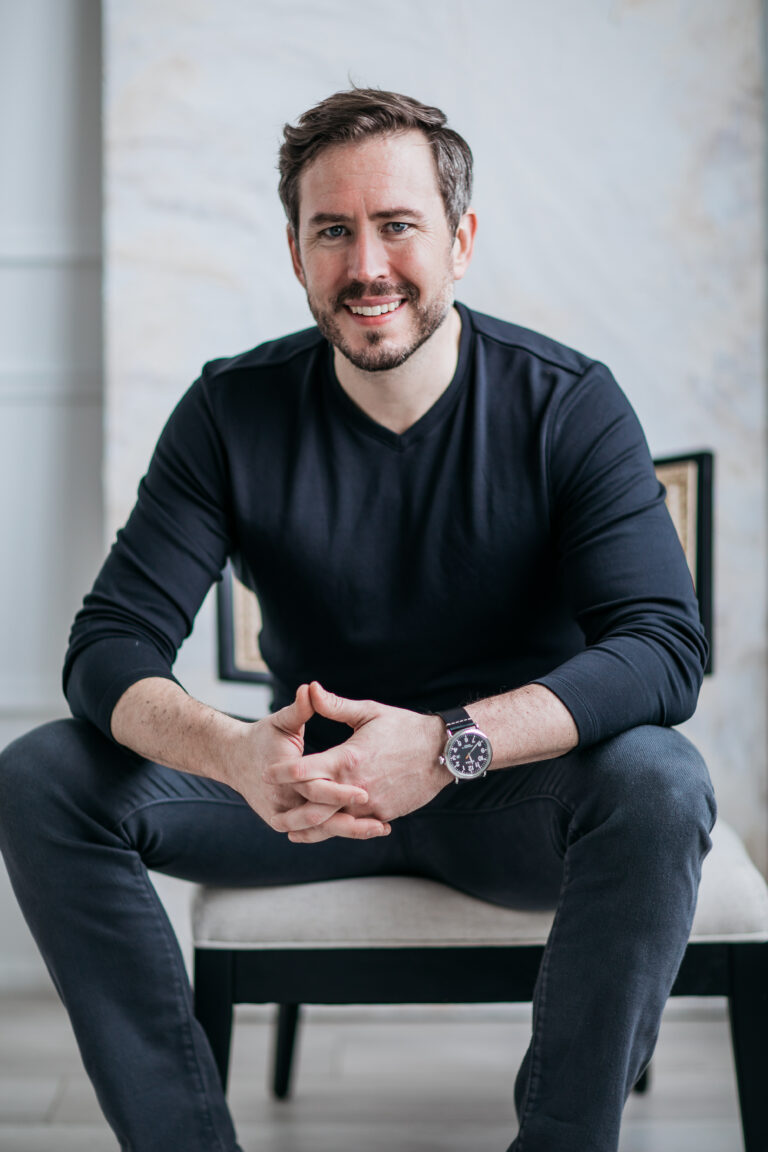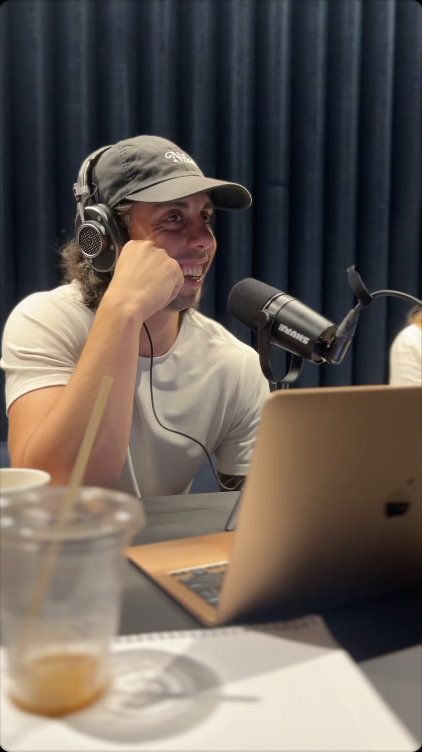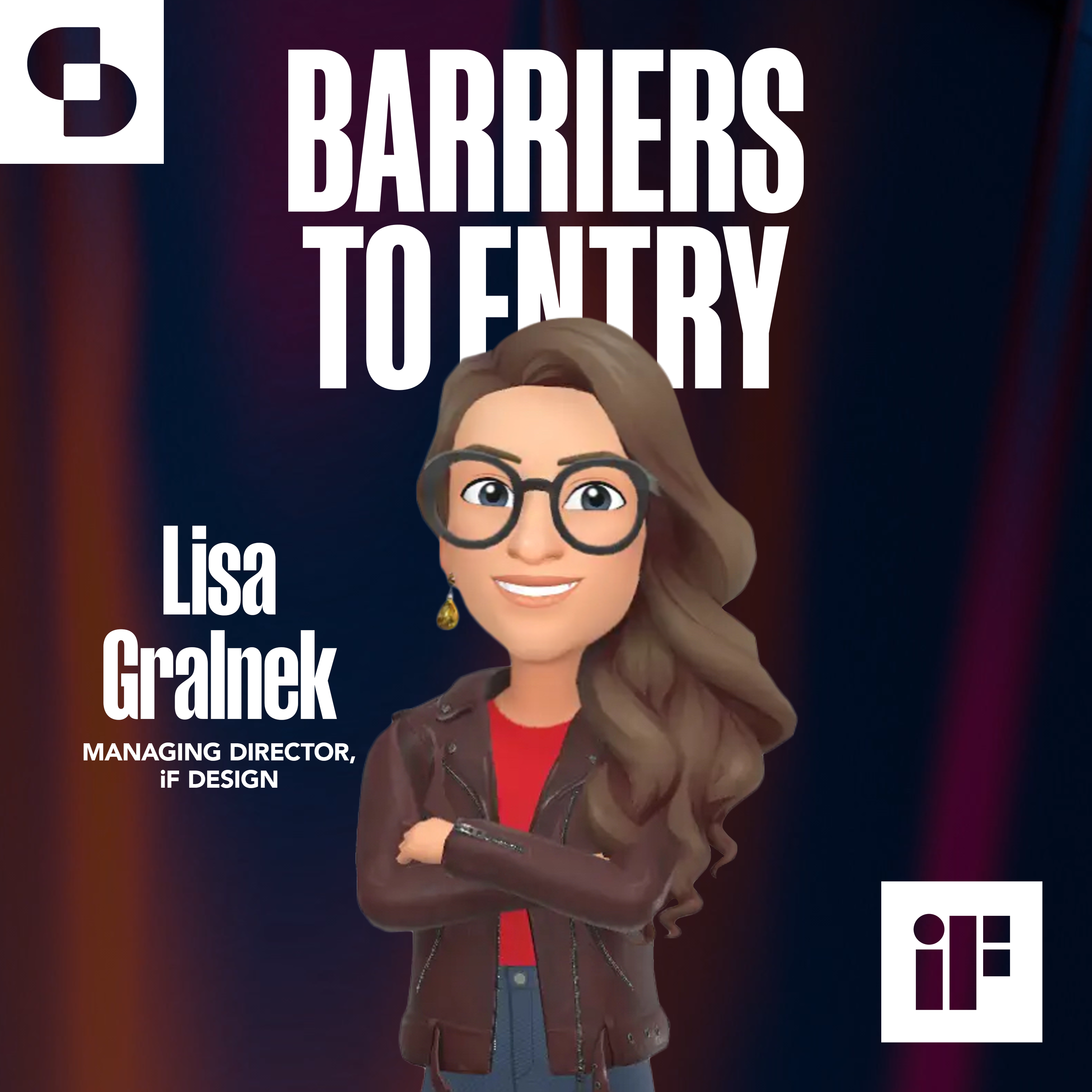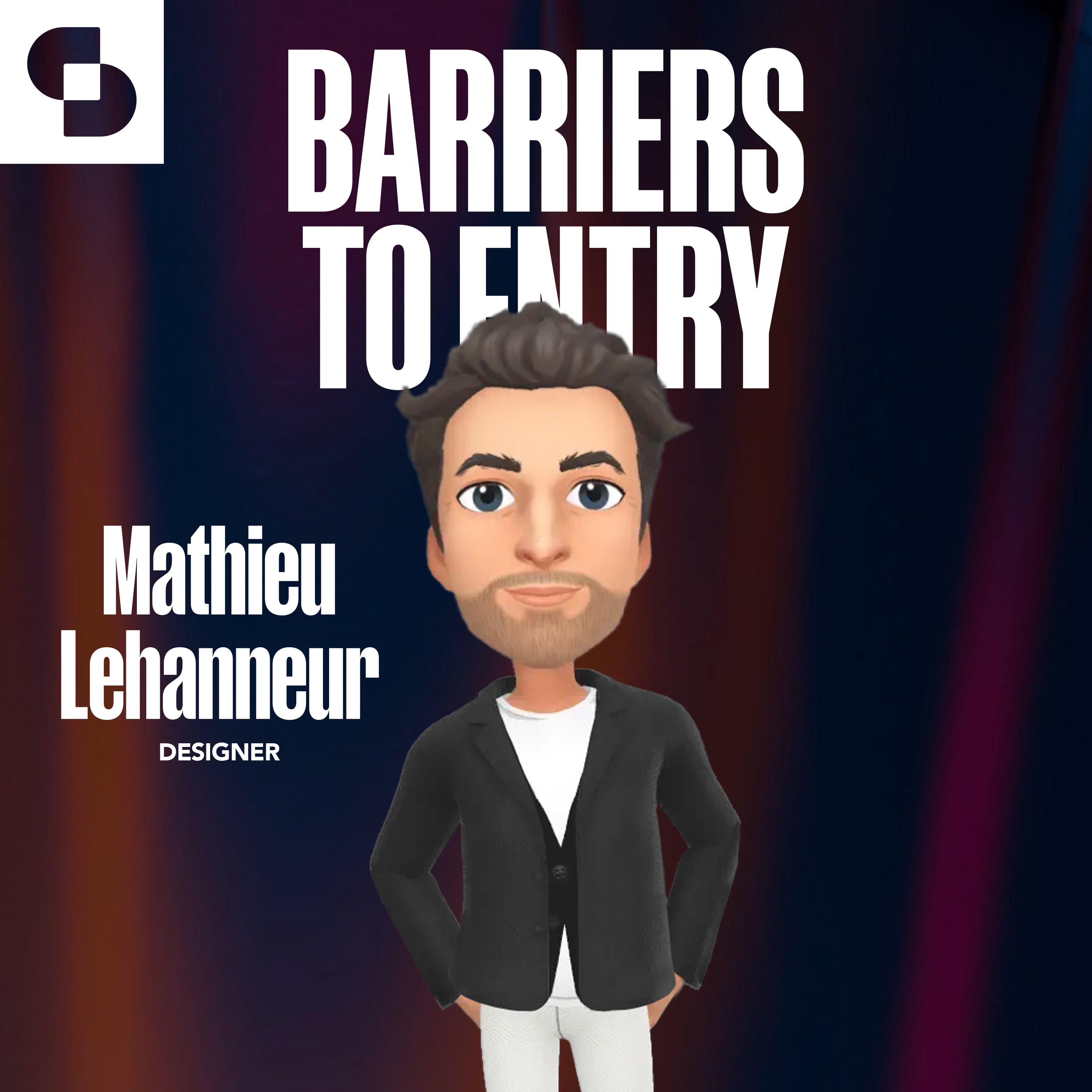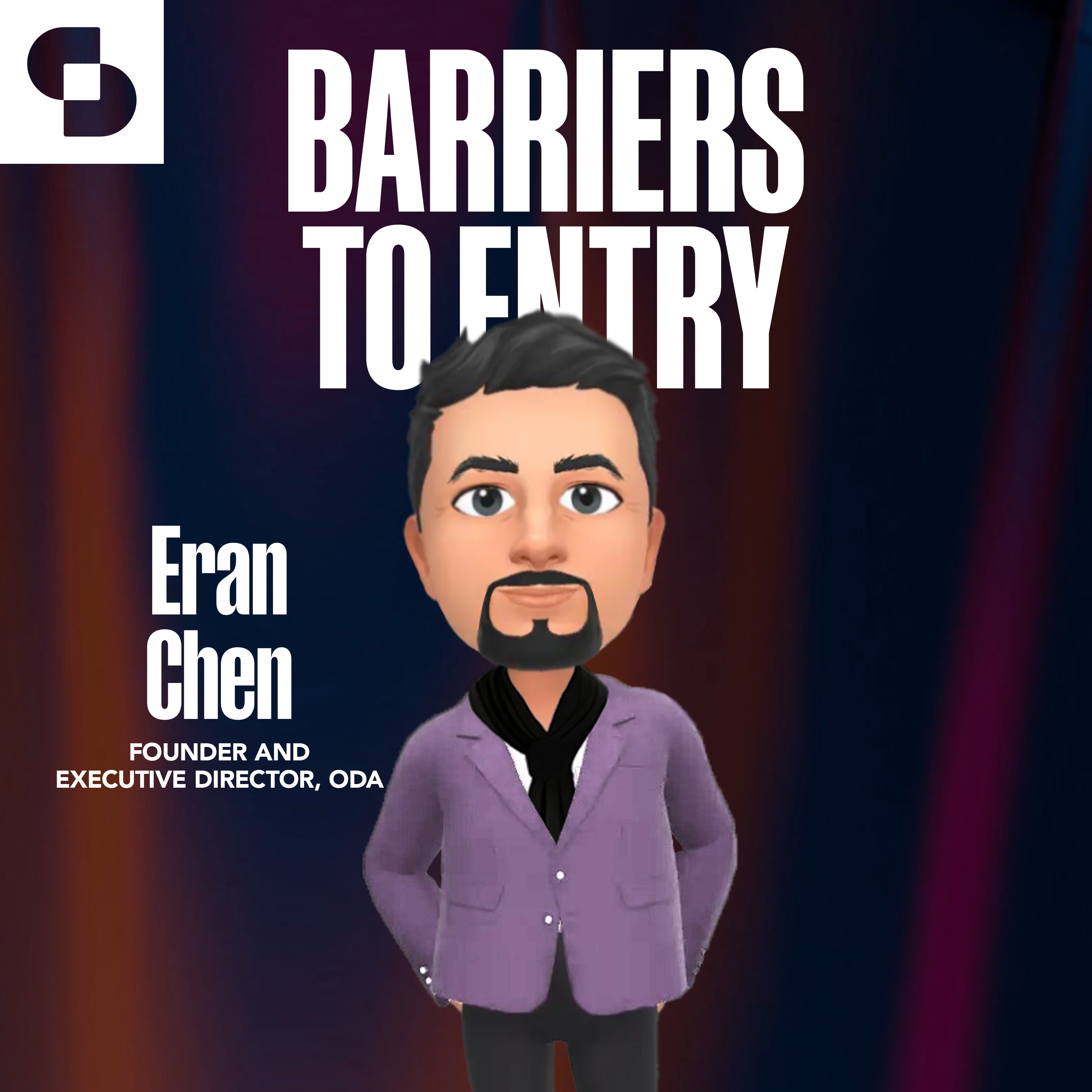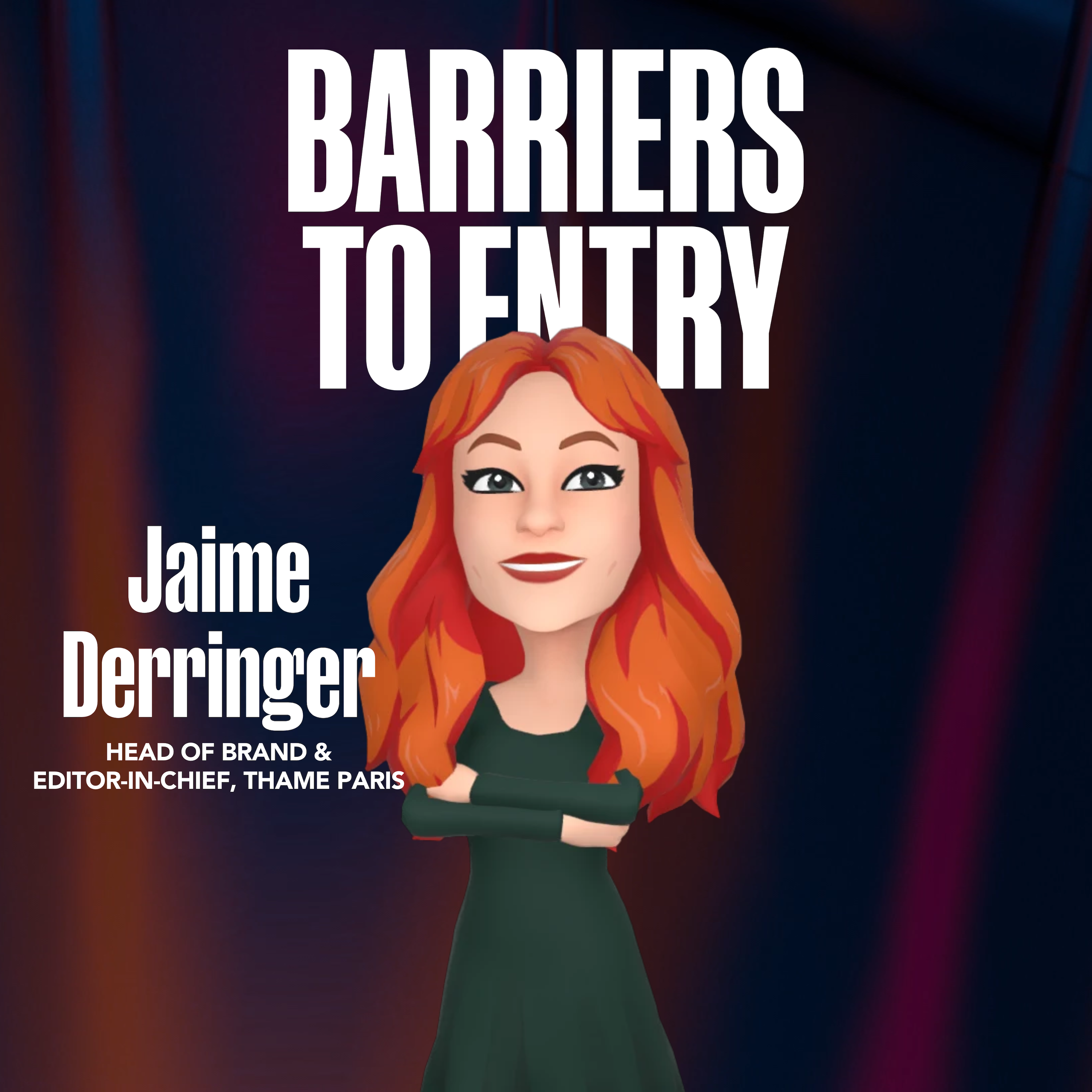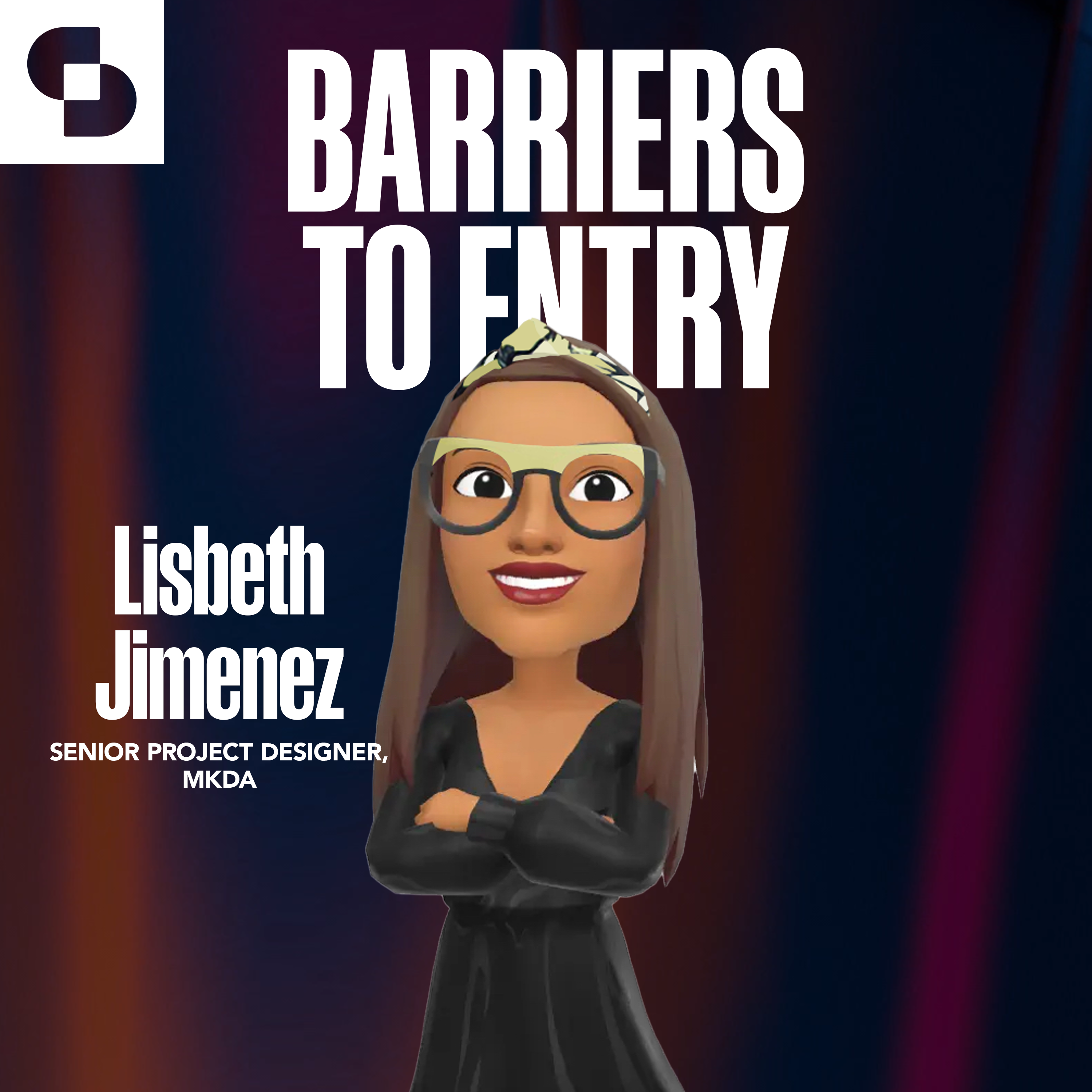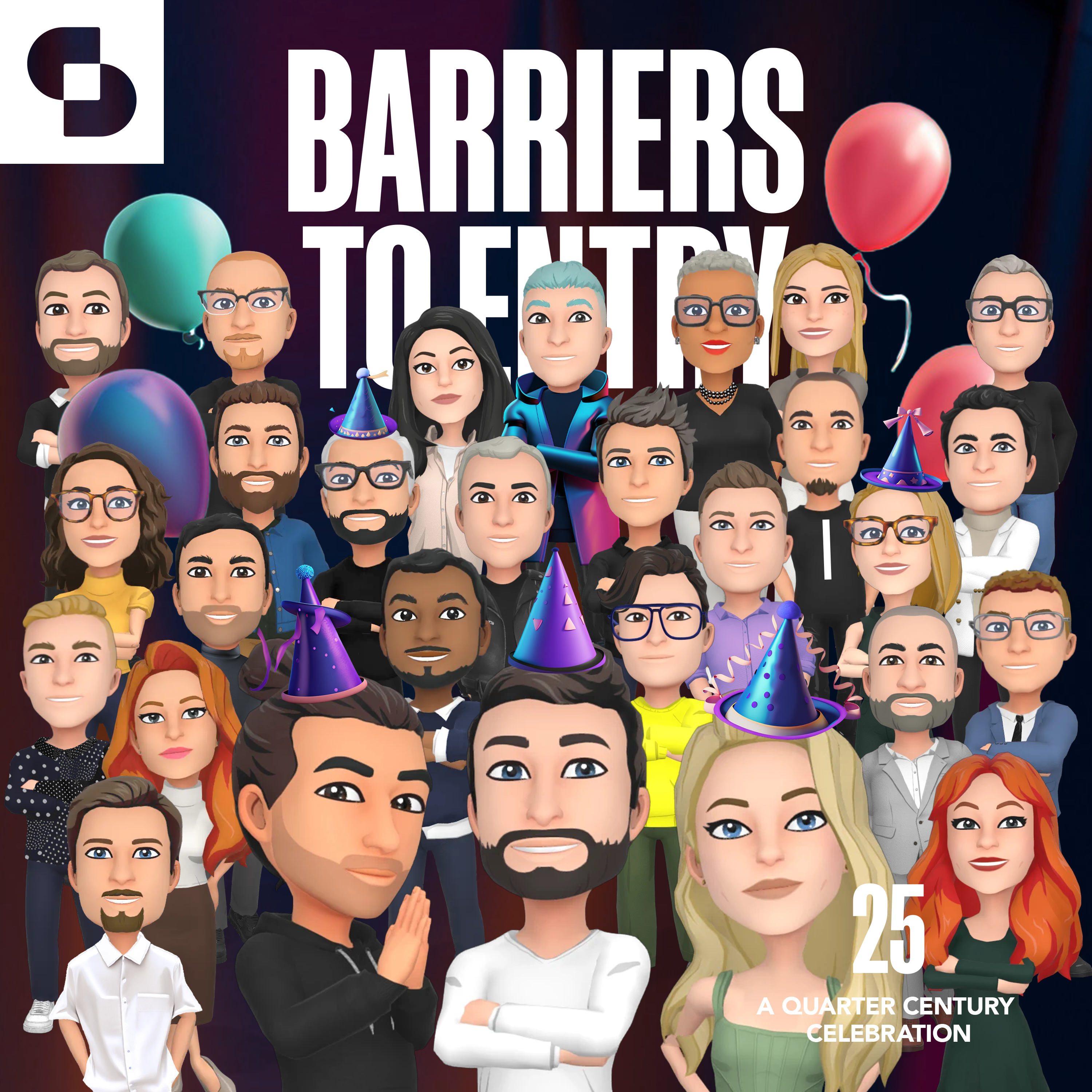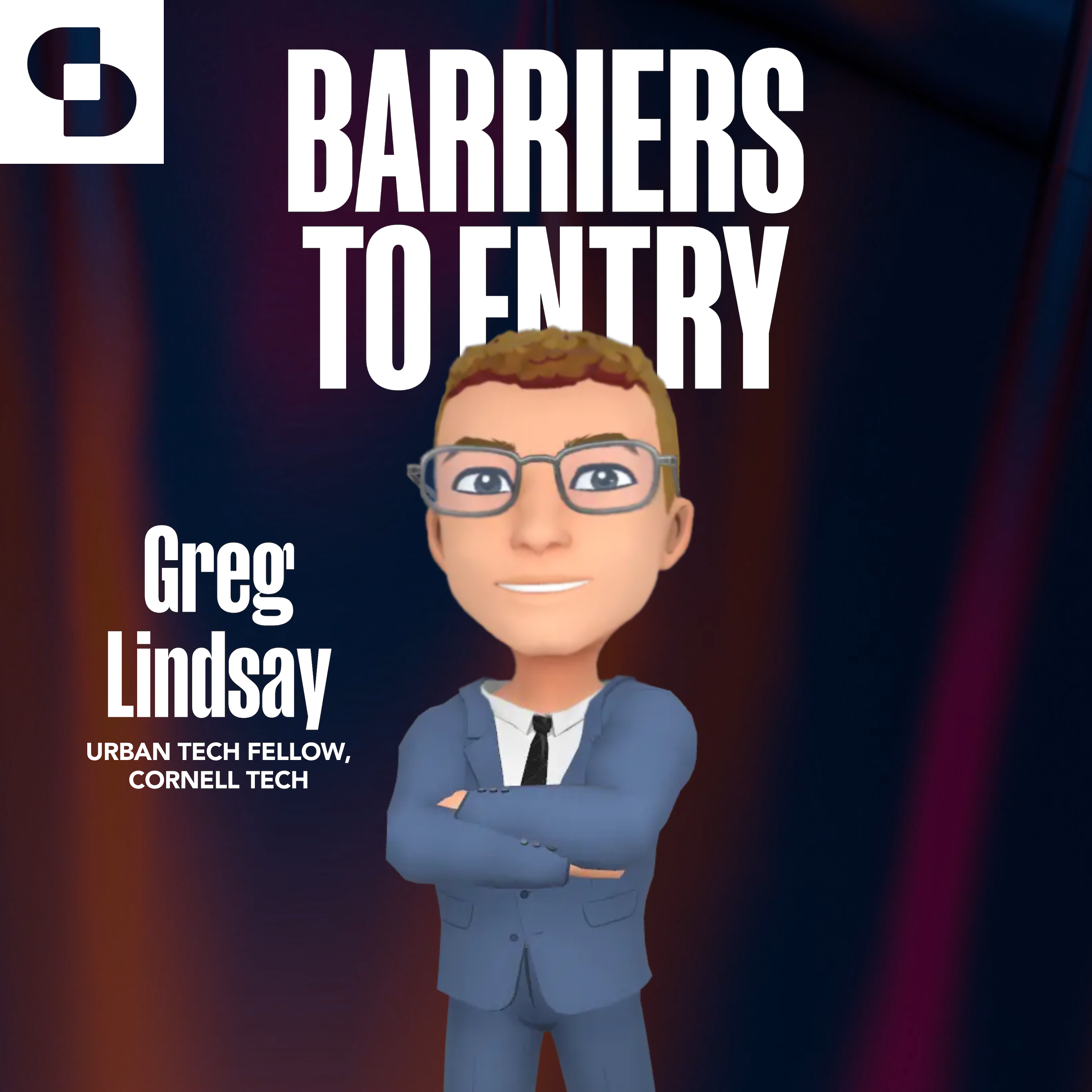We’re keeping it in the (SANDOW) family this week as we welcome the Editor-in-Chief of Metropolis Magazine, and leading thinker on industry sustainability, Avi Rajagopal. Buckle up as the team nerds out with Avi on everything from how blockchain technology can impact supply chain, to judging the first Interior Design Metaverse Architecture & Design Awards, to what Indigenous culture is teaching us about how how to use AI. If you’ve ever thought that your Alexa might need a hug from time to time, it’s a conversation you won’t want to miss.
Connect with Avi Rajagopal on LinkedIn!
Moments to check out:
- (11:35) Challenges with sustainable certification, and the possible role of technology
- (21:01) Why AI won’t take our jobs (and why we’re conditioned to fear that it will)
- (28:18) Metropolis meets the Metaverse
Connect with our hosts on LinkedIn;
References and resources:
- Metropolis Magazine
- Ronald Rael on Instagram
- Interior Design Metaverse Architecture & Design Awards finalists and winners
- Seven Generation Sustainability
- Metropolis Deep Green Podcast
- Metropolis Climate Toolkit
- Chat GPT
- Indigenous Artificial Intelligence Working Group
Discover more shows from SURROUND at surroundpodcasts.com.
This episode of Barriers to Entry was produced and edited by Wize Grazette and Samantha Sager.
Although the transcription is largely accurate, in some cases it is incomplete or inaccurate due to inaudible passages or transcription errors.
Avi Rajagopal: [00:00:00] I think the question is more, well, how do human beings become? Collaborators or partners with this technology. What is its place in our world? What does, I’m not going to say responsible use, but responsible collaboration with technology look like? Right, how do we build a healthy relationship with technology?
Bobby Bonett: Welcome to Barriers to Entry, the podcast where every episode we get into it with the leaders, the designers, the early adopters, and the influencers who are driving innovation. In the architecture and design industry, it’s the metaverse, it’s AI, it’s blockchain, and it’s all happening here. I’m Bobby Bonett and as always I’m joined by my ravishing co hosts Andrew Lane and Tessa Bain, Andrew, and Tess, how are you both doing today?
Andrew Lane: I’m ravishing. I’m ravishing. You called it. You hit it right on the nose. Thanks, Bobby. Appreciate that. How are you feeling, Tess?
Tessa Bain: I mean, I was doing so much better for a second there. I was actually doing a lot better once you
Bobby Bonett: called [00:01:00] me ravishing. Good. I’m glad to hear that.
Well, we were just hanging out in New York just a couple days ago at the Perspectives Thanks. where we got to meet up with a couple past barriers to entry guests. Isn’t that right, Andrew?
Andrew Lane: Yeah, it was the room full of alumni, which was really exciting for us. And, you know, we were able to host a panel talking about innovation and how to really drive that into your business.
But we also got to hear from today’s podcast guests, Avi Rajagopal, and he spoke with Megan Sherwin from Keilhauer about sustainability, which was. One of the many great conversations that happened on that day. And just always refreshing to hear from Avi, which is one of the reasons why we were so excited when we got the chance to have him as a guest on BTE smack dab in the middle of the summer of BTE.
Bobby Bonett: So for those who don’t know, Perspectives is a conference standup design group organized this summer. And our goal with Perspectives was to bring dozens of marketing leaders from the architecture and design industry together. To chat about [00:02:00] the challenges that we deal with as marketers on a day to day basis, whether that’s embedding innovation within your organization, which is something we chat about on barriers to entry.
In each episode, whether that’s how to market your sustainability message, which is what Avi and Megan chatted about, or any other host of topics. There was a module on the supply chain. There was a module that focused on a B2B marketing at a high level. But I mean, it was nice to see all of these principles come together.
And today, as Andrew mentioned, will be a microcosm of that in our chatting with Avi about where sustainability comes together with emerging technologies. And we’ll talk about AI. We’ll talk about the metaverse. We’ll talk about a host of other topics with Avi, who was really a fantastic guest. Yeah,
Andrew Lane: that was well plugged, Bobby.
And I love the breadth of this conversation. We even get into hundreds of year olds of indigenous philosophy and how that’s impacting artificial intelligence. So not your average pod conversation, but what do you think Tess, should we get into it? Let’s get into
Bobby Bonett: it. [00:03:00] We’re here at the podcast studio at Penn One today and we’re keeping it in the Sandow Design Group family on barriers to entry.
Joining us is Avi Rajagopal. Editor in chief of Metropolis. Metropolis is a 40 plus year media institution, spotlighting the opportunities and challenges presented at the intersection of architecture and design, including sustainability, technology, accessibility, and social impact. Avi is also an author, a frequent public speaker, and Avi, I think it’s fair to call you an expert on 3D printing as well.
Avi Rajagopal: Yeah. Fair. If you can call anyone an expert who’s never printed anything more than six inches tall. But sure. That sounds good. Well, welcome
Bobby Bonett: to the show, Avi. We’re lucky to
Andrew Lane: have you today. And don’t, don’t hate on miniatures. Everyone loves a good miniature. Oh
Avi Rajagopal: yeah. Oh yeah. For a while, they were the future of 3D printing.
Andrew Lane: Absolutely. Absolutely. Well, let’s go back into your background. Maybe not quite 3D printing, but Premetropolis, can you tell us a bit about where your passion for architecture started and how you came to Metropolis in the first place? [00:04:00]
Avi Rajagopal: Sure. I studied industrial design in India at the National Institute of Design in Ahmedabad, India.
It’s one of the first design schools that was set up in Asia and the school, you know, design was taught there really as a kind of mission led. activity. Some of that baggage comes from, you know, the 60s, of course. So thinking about sustainability, thinking about craft, thinking about, you know, where stuff comes from and what its purpose is in the world was very much a part of my design education.
I came to New York to do a master’s in design criticism and started as an intern at Metropolis while I was in that program and then never left. That’s great. Work your
Andrew Lane: way up from the, from the bottom.
Bobby Bonett: And then you were blogging as an intern or, or did you pick that up soon after?
Avi Rajagopal: I picked it up soon after.
So that’s right. So I did a summer internship and then. I was the very first web intern at Metropolis, and then I started blogging for them. So I would [00:05:00] come in three days a week and produce one to two pieces every day I was in. It was really exciting. You know, I got to write about a lot of stuff and a lot of very different stuff.
And I had a, I mean, I was pretty much given free reign. So I did what I wanted, which was amazing. I think
Bobby Bonett: one of the first times we spoke when we met, I guess three and a half years ago, I asked you the same question, so I’ll put you on the spot again. What was one of the first things you wrote about as a blogger for Metropolis?
Or maybe the first thing, if you can remember. I do
Avi Rajagopal: remember the first thing. The very first thing I wrote about was about the Buckminster Fuller Challenge. You know, it was named after the great architect Buckminster Fuller and the idea was that they gave a huge prize, like, well, now we don’t think of that as huge anymore.
RuPaul’s Drag Race has a bigger prize, but it was 100, 000. And the 100, 000 went to a project that showed that it was creating a holistic, positive impact in the world in terms of, you know, Environmental work and so on. And so I covered the winners of that year’s challenge. That was my very first post for [00:06:00] Metropolis.
My first feature in Metropolis was about a building in Brooklyn that had been taken over by a group of makers and hackers and small architecture firms. Some of those folks now are, you know, leaders in the industry, Maria Ailova, who was at Terraform One at that time, now head of iLab at AECOM. So, you know, just at that time, I had no idea.
I was talking to her about chicken coops on their roof. But, you know, it was really about this new… A way of thinking very much informed by peer to peer networks, informed by maker culture, hacker culture, which was also the work I was doing as part of my master’s thesis at that time. So it kind of all came together.
Yeah.
Bobby Bonett: Metropolis is, is beloved in our industry. When did you fall in love with the brand and what made you fall in love with the brand? Were you aware of Metropolis when you joined as an intern? Were you in love with the brand at that point or as you started writing, as you started meeting the community?
As you know, Representative Metropolis, did you find yourself starting to
Avi Rajagopal: [00:07:00] fall in love? I mean, I read Metropolis when I was a student in India. We had a few issues in our library at design school. I always found it interesting. I won’t say that I had a very sophisticated understanding of what Metropolis was.
The day I started as an intern, and I recently put this into my editor’s letter for our 40th anniversary. The day I started Metropolis, Susan Snazzy, who was the editor in chief then, was writing her own blog post basically decrying Frank Gehry because Frank Gehry had said that all sustainability certifications were bogus and Susan was up in arms.
There was you know metaphorical smoke billowing out of her office You could sense that everybody was you know, really mad and I think you know that spirit is very much for me That is very metropolis. We’re not pessimists. We’re not naysayers. We’re looking to the future we We don’t like people who are cynical about change, and that’s very much stayed with [00:08:00] me as a, you know, guiding spirit for what Metropolis does.
Tessa Bain: And you’ve touched on this just a little bit, but can you go into a bit more depth on how Metropolis views its responsibility and not just to the architecture and design industry, but to the planet, given its platform?
Avi Rajagopal: Metropolis has a really long legacy, and I think At least from my kind of analysis of our archives and looking at all the stories we’ve produced over now, you know, 42 years is I think the, the magazine always had a future looking perspective, right?
So it was always about what is the future of architecture and design going to be like, but that was really a way of asking. What is the future of the environments that we design and then live in and so on, you know? What are they going to be like and how should they be shaped? Which is a slightly different type of question and that led us to Having a much more analytical approach diving deep into stories So different people will say different things about metropolis [00:09:00] to me people like oh you’re You’re a very journalistic magazine.
That is true. Like, oh, you write a lot about process. That is also true. Oh, you publish a lot of criticism. That is also true. But all those things really come from the sense of responsibility being like, you know, as a community of professionals, and we are a trade publication. So we take that responsibility to the trade very seriously.
But our responsibility is helping the architecture and design industry. understand, appreciate, and embrace its role in sort of shaping the world for all of us. And I think that’s where that deep concern with sustainability comes from. And on the sustainability side, you know, we’ve had some great milestones.
We were the first publication to talk about the carbon emissions of architecture in 2003. But our first, very first issue in 1981 had a whole story about solar power, right? And solar powered homes. So it’s been a thread that’s, you know, run through [00:10:00] the history of the publication, but that interest in sustainability comes not just from the world needs to be safe perspective, but really also saying this is a professional responsibility for architects, interior designers, product manufacturers, contractors, developers, everybody in the building industry that we have a role to play.
Is it
Bobby Bonett: exhausting to be an optimist?
Avi Rajagopal: No, I think actually it’s really energizing. You know, I feel like If you don’t ever let go of this idea that, okay, every day people come up with great ideas and everybody’s creativity is valid and there’s, you make your task, not judging what they’ve done, but sifting through what the, what people in the world are doing to find those little nuggets, to find those ideas, you know, this morning I’m coming from a showroom, looking at new releases in flooring.
And yes, I’m paying attention to what they’ve done with the flooring, but I’m also listening very closely to [00:11:00] where their sources of inspiration are, what, how does it fit with larger cultural trends? You know, we ended up having a long discussion about the last of us and whether fungi or algae are going to save the world or destroy the world.
It’s, you know, I think that’s, that’s the interesting part of being an optimist is I think you, you We’re always looking for things to make you smile. Is this
Andrew Lane: like a team fungi versus team algae thing or is it them all working
Avi Rajagopal: together? Oh, no, it’s definitely team fungi versus team
Tessa Bain: algae. It’s just looking for a new t shirt concept.
Definitely. So you’re an optimist and not to be a bit of a pessimist, but is it fair to say that there are some serious problems when it comes to sustainable specification? And I know we had talked before you brought up a textile example.
Avi Rajagopal: Oh, yeah, absolutely. So once we accept that the building industry has an impact in the world, and it has an impact in a few different ways, to quickly summarize, the building industry is responsible for about 40% of the world’s carbon emissions.
Now, a lot of industries claim that they are responsible for 40% of the world’s [00:12:00] carbon emissions, but the way you have to think about it is influence, right? So if there is a full pie of carbon emissions that we’re emitting as human society every year. There’s some parts of it, like transportation or manufacturing, that feed into both the building industry and into fashion, for example.
Right? So, it’s about… Us claiming our part of what those emissions are, right? How much transportation is tied in into actually transporting goods to buildings, for instance. So, anyway, 40%. But also, construction is the second sector most at risk for labor exploitation around the world, right? So, we have a deep implication in matters of equity and fairness around the world.
Also, the building industry is said to be the second largest consumer of fossil fuels in the world. And that comes not from using petroleum to power buildings, which we don’t do directly, but actually from plastic. So, fossil fuel use for plastic is said to outrank fossil fuel use [00:13:00] for energy, if all our predictions about renewable energy come true.
And the second largest user of plastics in the world is the construction industry and the architecture and design industry. So, it depends. Like, if you’re a glass half full person like me, that means there’s so many more opportunities for us to have a framework within which we can take better decisions.
Anyway, so, that brings us to sustainable certification. Obviously, if we’re the second largest consumer in the world of plastics and therefore are going to become the second largest consumer of fossil fuels in the world, right, there is a responsibility in what materials we put into buildings. If we’re also the second sector at risk for labor exploitation, there’s also responsibility in terms of how we put our buildings together and how we put our spaces together.
So both of those things can be really complex. And then when you start to kind of, you know, unpeel the layers, when you start to go layer by layer. You come down to, well, the person making the product has to be able to tell us what is in the product and how [00:14:00] it’s made. Now, it’s easy for somebody looking outside to be like, well, we should just have full transparency.
People should tell us exactly what’s in everything, like, but very often the way our industry is structured and the way manufacturers do their, do their work with the best intentions, of course, um, it’s very complex, right? So you brought up textiles and textiles is a great example because we don’t think about textiles as a particularly complex product category, right?
But if you wanted some kind of general estimate of how much carbon emissions goes into, say, a square yard of textile. It’s actually a really complicated undertaking because textiles today are made up of many different type of materials. There are many different weave structures. Each of those things means a manufacturer could have thousands of textiles in their lines because it’s very easy for a loom to switch from one weaving structure to another weaving [00:15:00] structure.
It’s not like cars where an assembly line is set up and they’re basically putting out the same car over and over and over. The scales are different. So there’s a lot of diversity, let’s say, in materials in the textile sector. So then how do you track every single thing? How do you make estimates for carbon emissions when, you know, the same company produces things with 10% ion, 20% ion, 30% ion, 40% ion, right?
And then there, some of them are mixed with renewable resources, some of them are not. They’re treated in different ways. So even as something as simple as textile can quickly get very complicated once you start to dig into it, right? And my intention is not to overwhelm anyone with the complexity, but which is to say, you know, well Here’s maybe a place where we need help and we need new ways of managing information
Andrew Lane: One of the things we love about Metropolis and all our conversations is your passion and interest in technology Do you see the blockchain having a role to play in that part of the discussion or in any other adjacent areas?[00:16:00]
Avi Rajagopal: Absolutely, and I should give credit where credit is due. The person who put this term in my head was Kirsten Ritchie, who is a principal at Kensler. If you really look at it, if we want to take the right decisions in terms of picking the right product for buildings or spaces, we have to have information that is up to date, that has been put together with enough complexity.
But that has a simple interface, right? And all of these things are great applications for blockchain. So to give you an example, if you imagine a record, let’s say in blockchain terms, for every scale in the building industry. So imagine that a building has a record that tells you every single material, every single product that’s gone into the building, that that record lives with information on where those materials came from.
What quantities were used, how they were modified during the construction process, and so on and so forth. And then for each of those products, then there’s a nested record that tells you where the product was [00:17:00] made, who the suppliers were, you know, and all of that stuff, right? So now you can almost think of a
building, right? And that’s a really exciting idea because buildings are extremely resource intensive. And what happens is that there’s so many slippages of information, right? So, a contractor comes, does something new in this building that’s not in the original drawings. They don’t really record it anywhere except in their own files or in their own drawings.
The owner doesn’t know that this change has been made. 30 years from now, they want to pull down the wall and they figure out a pipe is running through it. Right? I’m being, well, I
Andrew Lane: know, and what we’re seeing companies in the construction industry that are emerging that are doing daily 3d scans of the construction process so that you know where every pipe is in every wall, not only from a future renovation standpoint, but also from an insurance and liability standpoint, there is a full 3d spatial record of every step at the construction of a building.
So this is [00:18:00] certainly happening in real time right now.
Avi Rajagopal: Absolutely. Right. Right. So what is happening is that Every layer at this point is independently figuring out its own information management system, right? So, if you look at construction, right, they’re doing 3D scans, and we did a story about this, I don’t know, like, seven years ago in Metropolis being like, you know, how 3D scanning can actually become a huge influencer in the construction industry, right?
So, it’s great. So, that’s at that level. But that information is not tied with information on the supply chains of the individual materials that have gone into the construction, right? That information is being managed by the manufacturers who have their own really complex information management systems.
Andrew Lane: And not open enough systems that they’re able to speak to each other.
Avi Rajagopal: Right. Right. Right. So the dream is if we can have a, you know, a universal system or a system that is consistent across different, you know, levels in the building industry that, you know, all of that information can stay together. It [00:19:00] becomes really critical when we start to think about things like the circular economy, right?
Or when we start to think about building reuse, right? Or if we’re starting to think about responsibly disposing of materials at the end of a building’s life or a space’s life, right? There’s that happening, information management. We know that there’s all this stuff about, you know, product certification, product databases.
So, there’s a whole sea of certifications because every product category deals, like I said, with textiles, every product category deals with its own complexity. So, each product category has developed its own certifications that it thinks are valid for sustainability in its sphere. Those are then gathered because, you know, a building might have a bill of materi or even an interior might have a bill of materials that run into hundreds of products.
Those are gathered into product databases, right? Like Mindful Materials or Ecomedies or, you know, any one of those. amazing databases, which are fantastic. But they rely on the manufacturers keeping the records up to date. They’re working on that, that’s great, but there’s no [00:20:00] way that that record then ladders up into record keeping on the building as a whole, which is where I see such amazing potential for Blockchain or any one of those technologies.
It would probably have to be a combination of Blockchain and then some kind of, you know, artificial intelligence that actually helps. People sort through and surface information that is necessary at each point in time. But I think there’s huge potential. Who do you think is the
Andrew Lane: ideal owner of that record?
Well,
Avi Rajagopal: the problem, the reason it doesn’t exist is because there isn’t an owner. But I think there’s a, there’s an entrepreneurial space that’s open there, right? I mean, we’ve seen… Free
Andrew Lane: business ideas on the pod today.
Avi Rajagopal: Oh, today, hopefully today’s episode will be full of these. But that’s what I mean. There’s opportunity.
There’s opportunity everywhere. You just have to recognize it for what it is. You have to have a very keen sense of what the incentives are and position a business carefully. But I think there’s, there’s, you know, so much work to be done. [00:21:00]
Bobby Bonett: Let’s move over to AI for a moment. You mentioned it just a second ago and in our pre call, you referenced artificial intelligence.
You’re not one of those folks who sits in the camp believing that AI is going to take all of our jobs as designers, right?
Avi Rajagopal: Yeah, I don’t think so. And I, you know, I feel like I’m borne out in that belief by history, by a whole bunch of other things. But I think there’s a historical kind of background to that anxiety.
And this comes from, again, giving credit where credit is due. Just last week we had an event called Design Optimism, haha, uh, in San Francisco. We’re all about optimism in Metropolis. And one of our speakers was the design anthropologist Dori Tunstall. She’s, uh, she laid out a lot of amazing things. I highly recommend her book, Decolonizing Design, absolutely fantastic.
There’s a huge section on it about our relationship with technology and where some of our anxieties around technology come from. But I think we always have this fear that, and it’s really [00:22:00] so weird, we create technologies specifically to do things. to have abilities that human beings have, and then we get scared that they’re going to come and take away our human abilities, right?
And the cycle has been going on forever. So I was reminded recently that the word robot actually comes from the Czech verb robota, which means forced work. Forced labor, right? Robots were slaves, like they were conceived of as slaves. And our overwhelming paradigm when it comes to technology is to think of technology as slaves.
Well, what are masters most scared about? Slave rebellions. Right? So then the matrix happens, like we have all this literature about, you know, the Terminator rising, the Terminator. Right, exactly. But that comes from this mentality of, you know. We create a power dynamic with technology where we want to be the masters and we want something to be enslaved to us.
And [00:23:00] so, I think we need a different way of thinking and I can talk about that a little bit, but when it comes to AI, you know, it depends on how you perceive the technology, right? I can, I could maybe comfort you and say, Oh, there are things that human beings can do that AI will never be able to do. But there’s little comfort in that, because we’ve seen AI take on things that human beings can do.
I think the question is more, well, how do human beings become collaborators or partners with this technology? What is its place in our world? What does, I’m not going to say responsible use, but responsible collaboration with technology look like? Right, how do we build a healthy relationship with technology?
I think those are the questions I’m interested in. I think that’s a really good
Tessa Bain: reminder to hug your Alexa.
It makes me want to say please and thank you a
Bobby Bonett: little more.
Andrew Lane: There’s a lot of people who are doing that though, like training, like whether it’s for kids or just making sure that you [00:24:00] thank your personal, your personal digital assistant and things like that. Like I think there’s a, there’s a, there’s a bit of a karma piece to it, but I think it’s just, you know, good etiquette as well.
We shouldn’t be treating, treating these robots
Bobby Bonett: badly.
Tessa Bain: And to your point, collaborative, which I think is important. So, what are the ways in which you’re seeing AI drive inclusivity in design? When we spoke before, you talked about it not only driving new design aesthetics, but also pushing us away from Eurocentric
Avi Rajagopal: architecture.
Right, right. Let’s start with an example. So there’s this artist, architect, activist based out of the Bay Area, Ronald Ryle. He and his partner, Virginia San Fratello. Who are on the cover of Metropolis Jan Feb issue, have won lots of awards for their work. They do all kinds of work. They were early 3D printing pioneers, actually, to come full circle, Bobby.
But, you know, one of the… It all goes back to 3D printing. But one of the very interesting things that I’ve seen Ronald and Virginia take on is earth architecture, [00:25:00] right? So, their early 3D printing experiments were about 3D printing with humble materials. So not 3D printing necessarily with plastic. But with sand and clay and stuff like that, and that’s led them to 3D printing, if you call it that, digital fabrication of buildings, right?
And they’ve started experimenting with mud architecture, right? Building buildings out of clay. Turns out it’s a great medium to use with a robot that builds buildings. You know, it’s amazing because it has all the properties you need if you have the right clay mix and so on. But, you know, those material concerns were the same material concerns that You know, indigenous communities, you know, all over the Americas had when they built say adobe buildings or mud buildings, we have a civilizational history with mud architecture, right?
And then on the sustainability side, I see architects interested in rammed earth construction, for instance, right? So what’s amazing is I saw Ronald start to use Visualization software or [00:26:00] whatever, right? Um, using AI to start to imagine new forms for mud buildings, earth buildings, right? And the prompts that he was feeding it, and this is on his, you know, stuff on Instagram, and you can find it, R R A E L is his handle.
Yeah, we’ll put it in show notes for sure, yeah. And some of the things he came up with, you know, are you can clearly see there’s influences from indigenous architecture. There’s a new technology, right, and then there’s this thinking about sustainability, right, that’s, that’s very today or old as time, depending on how you look at it, right?
It’s interesting that AI becomes the kind of engine or the, or the collaborative partner that enables You know, really complex aesthetic thinking, construction thinking, and so on. Right. So I think those kinds of applications of AI are really exciting to me. It’s one of the winners of the metaverse architecture and design awards that, you know, of course, [00:27:00] um, we’re familiar.
Yeah. Yeah. You’re familiar. And I was a judge. I was, I was so glad to see, you know, forested environments win in the innovation category, because I think one of the things is, can we use AI to help us to help us imagine different futures, right? Help us imagine, sort of, ways of being in the world that maybe we’ve, we’ve said to ourselves in our dreams but haven’t actually been able to see and therefore make tangible.
And I think that’s really interesting. Also, if, I love how, like, even the most fantastic spaces, like, oh, like, people who say, like, I created this thing in the metaverse and it has… And it follows no rules of, you know, human architecture, and yet it’s, it’s sitting in a space with blue sky and earth below, you know, like, I think this, we cannot take our human perception out of nature, much as we can play around [00:28:00] with the rules of the built environment, we can’t play around that much with the rules of the natural environment, and I, the examples of artificial intelligence, the metaverse, you know, all of that, where we start to examine that relationship and start to That’s really exciting to me.
I
Andrew Lane: think I wanted to go back in history a tiny bit. It was about two years ago that you published a series of articles in Metropolis on the metaverse. And I’m curious kind of what was it that led you to dive into that topic at that time, which was quite early, um, from a lot of people’s standpoints and sort of how have you having your opinion have things evolved since you put all of that to print?
Avi Rajagopal: Yeah, we did that issue on the metaverse, which was our, um, our first Jan Feb 2021 issue, I believe, not just because the metaverse was a growing trend, but also because it seemed to reflect back to us patterns of our relationship with technology that we’ve seen in other places, right? So we were interested in the metaverse itself, but also we were [00:29:00] interested in the metaverse as sort of the new iteration of like the same old short sighted thinking, right?
In some ways, but at the same time, we want to embrace and celebrate. Creative expression and, you know, people being children with this new playmate and inventing new games with this thing, right? And so, there was a lot of that going on. But at the same time, we were like, we, we can’t continue in this fiction that, like, the digital world is somehow this…
World without consequences. Right. Even as, and you have to remember, this was, you know, hot on the heels of Facebook’s rebranding. Mm-hmm. . But Facebook’s rebranding happened in the context of Cambridge Analytica to take all of you back to late 2020, early 2021. There still is, you know, real anxiety about lives that are lived online, right?
Mm-hmm. . And so we were like, okay, we’re creating this new, pulling together. different imaginations of what lives can be online into this thing we call the metaverse, [00:30:00] let’s not, you know, kind of leave out the problematics that, you know, have always existed. So we did an article about will the metaverse be accessible, right?
Early days, you know, there were, we saw both camps. Folks were saying, oh, VR headsets are the best things for people with both physical and cognitive disabilities, right? But at the same time, we were seeing studies that said that VR headsets made women more nauseous than men. I’m not going to buy into gender thinking, but you know what I mean.
Like, I think there’s this, like, um, we were holding something up as hope while not addressing the problems that existed. So we love to live in that place in Metropolis. We want to say, hey, let’s be optimistic, but we can be optimistic if we are thoughtful, right? If we’re thoughtful now, then, you know, maybe we can head off some of the things that will cause us to be pessimistic later.
I think
Bobby Bonett: most of our guests have had a pretty strong opinion about that word Metaverse and the words role in leading people to adopt that technology specifically in the architecture and design industry and to [00:31:00] Andrew’s point, you’re writing about it. Two and a half years ago, and I’m still talking about metaverses now, but in many different ways, virtual environments, virtual worlds, et cetera, I’m wondering in the conversations you have with designers and manufacturers, when you do start to chat about the concept of a metaverse, what you’re feeling is about that word, whether that’s an encumbrance in terms of driving adoption and making people think about a virtual space, if that word is intimidating to folks, or if you’re like, it’s just a word, I really don’t care.
You know, why are you asking this question?
Avi Rajagopal: You know, I think…
Andrew Lane: That happens a lot when Bobby asks questions. I actually
Avi Rajagopal: thought it was a really good question. No, it is a fantastic question. And I think… Um, you know, I’ve stopped caring when people roll their eyes about stuff. Uh, so I always get the word metaverse with the roll of an eye, like whether it’s an actual physical roll of an eye or like it’s in tone or whatever.
We like to do
Andrew Lane: air quotes, but it doesn’t work as well in an audio format. Scare
Avi Rajagopal: quotes. Scare quotes. Yeah. But it’s such a useful word. I mean, we finally have a word that embraces [00:32:00] the full spectrum of a. You know, a digital life that layers and has an interaction with your physical, tangible life. I mean, the word existed, but it wasn’t adopted, and yes, I know the word, like, comes from Mark Zuckerberg, and, you know, maybe, you know, that’s not such a great provenance, but like I think he tried to
Andrew Lane: steal it from Neal
Avi Rajagopal: Stephenson.
He stole it from Neal Stephenson. Yeah. Yeah, yeah, yeah. But I’m saying, like, it comes to us in our present cultural moment from Mark Zuckerberg. It’s just a useful word. I think it’s actually a really good word. When people roll their eyes at it, I think it speaks to, again They’re anxieties and they’re fears and they should be anxious and they should be scared because it’s unknown, right?
It’s something we’re building as we go along and I mean, it’s human that for us to be scared and anxious. It’s just, you know, we shouldn’t turn anxiety into bravado. We should turn it into care and responsibility anyway. Bringing it back
Tessa Bain: just a little bit. You were a [00:33:00] juror in the Interior Design’s Inaugural Metaverse Architecture and Design Award show.
What were some of your takeaways from the design work and from the submitters
Avi Rajagopal: themselves? First of all, I was blown away by the number of entries we got. There’s so many people really excited about doing work in this arena. I think I’m, one of my, of course, like, kind of side takeaways was this relationship with nature, you know, lots of natural environments being replicated in the metaverse, and I think it says something about our present cultural moment as well, as we’re increasingly concerned with biophilia and our relationship with nature and, you know, so on and so forth.
Um, I was particularly, I think, drawn to, um, either provocative projects, um, like the forest environments project that, raised larger questions, right? Um, and used, um, a host of either intelligent or virtual technologies to do that, or that, um, provided new capabilities, right? Um, and, [00:34:00] you know, so I think the, it was a, it was a very affirming exercise for me to, to look at those entries.
You know, I think if there was a little part of me that was, you know, ready to dismiss Uh, metaverse projects as sort of, you know, 3D models, um, you know, just by a new name. I think I was disabused of that idea. I think it was really, really great. I
Andrew Lane: appreciated your comment. It’s just before Tess asked the question to about the all encompassing nature of the word.
And like when we were kicking around, what could this awards program be called? I think we landed on metaverse because love it or hate it. Everyone knows exactly what you’re talking about as soon as you lay it out there. And I mean, really it’s an innovation award show. We have awards for AI. We have awards for blockchain.
You know, we have awards for, for other areas as well, but I think it was, it was a great word. That that made people understand the breadth of what we were trying to speak to and also, you know, a cute little acronym in the end with [00:35:00] mad. So it all kind of worked out, but was happy to hear that. That point of view from you as well.
Yeah.
Bobby Bonett: So let’s bring it all together between sustainability, AI and the metaverse. I think I don’t know if it’s if you’ve raised the question, Avi, or if it came up on on the Metropolis podcast, deep green, can we build an online world that doesn’t destroy the real one? Um, it’s a daunting question. And I’m wondering, we’ve talked about optimism before, are you hopeful that we can build an online world responsibly?
Avi Rajagopal: I mean, I have to be. The online world is already being built. I think the question is, you know, are we learning our lessons when it comes to responsibility? Two things I want to bring up here. I’ve said before that we think of this online world as without consequences. That particular line, can we build the online world without destroying the real one, came from one of our writers, Audrey Gray, shout out Audrey.
She was writing about carbon neutral and net zero data centers, right? So the idea is that, you know, we talk about chat GPT as though, oh, [00:36:00] there’s this like magical being, or this like, you know, like, you know, digital slave somewhere that’s bringing us answers and doing our work for us, but it’s running on.
Huge amounts of energy, right? And that energy comes from the real world. Like, nothing exists without basis in, you know, really energy on this planet, right? And so, the idea was, well, if we look at the metaverse, we also have to look at data farms, right? We have to look at, you know, what is the energy used for computation?
And how is that energy being derived? And will… Huge computational loads end up, you know, creating this massive, you know, energy burn. I like to throw random facts in and one random fact is that in 2019 the second highest use of Electricity in domestic applications in the state of California was gaming.
Yeah. So heating and cooling were number one, but [00:37:00] number two was gaming. One
Andrew Lane: of the ways we like to talk about metaverse is the unflattening of the internet. And so, you know, when we talk about a virtual world, we already have a virtual world. It’s called the internet. We’ve been using it for 30 years. Now we’re going to need that additional computational power to turn everything that used to be flat into something that’s three dimensional.
You know, plus at the same time, all the architecture and design firms that we’re talking to are bringing these sort of 3D experiences into screens and into different interfaces that exist in the physical world. So I think it is something that’s, that’s really going to be an important conversation over the coming years because the computational power that’s required for this increasingly lush and immersive experiences that we’re creating both in physical and digital spaces is going to be significant.
Avi Rajagopal: Yeah, absolutely. And I think, so that’s one way in which We have to bring perspectives from the physical built environment to the digital built environment, say, you know, like we have to, we have to make those connections. Another way is really our, our general approach to design. And [00:38:00] again, shout out to Dori Tunstall at Design Optimism, our event in San Francisco.
You know, she brought to our attention. a group that’s called Indigenous Knowledge and Artificial Intelligence. You can go to their website, indigenous ai. net. I mean, it’s a group of academics and technologists, many of whom come from indigenous backgrounds, thinking about how do we change our relationship to technology, right?
And one of the tenets of indigenous thinking, at least, In North America, and this is shared by many indigenous groups in North America, is you might have heard of this term, seven generations thinking right. So the idea was that if you were a leader in a community and you were taking large decisions on behalf of people, the standard you had to apply for your decision is.
What are the consequences of this decision for the next seven generations, right? We are not even in two generation thinking when, when we talk about physical architecture [00:39:00] and we are pretty much in no generation thinking when we talk about digital architecture. I
Andrew Lane: think we’re in three generation thinking with mortgages now, but that’s about it.
Avi Rajagopal: Exactly, exactly. Well, where money is concerned. So I think the question is, how do we bring some of that longterm thinking? into the digital world. How do we stop thinking about digital design as A, ephemeral, B, having no consequence, C, being in service to us or in servitude to us, right, and instead start to treat digital technology with respect, right?
Another big perspective that comes from, you know, the indigenous way of looking at the world is indigenous communities often refer to aspects of nature or the world through kinship terms. You know, like. Brother Moon, Sister Tree, Brother Wolf, and it’s, it sounds weird, but what it does is basically, it’s a worldview that says, these things are not here to [00:40:00] serve me as human beings.
I’m in relationship with them, so I have to, we’re It’s weird. Like, would you think of yourself as in service to your siblings or your siblings as in service to you? You know, it, it takes it out of that equation. And so, you know, what do we do with Sister Alexa? How do we think about AI as a partner that we bring into our process, into, you know, our ways of thinking, but in a respectful way?
How do we create a metaverse that is built on… Respectful, non exploitative relationships, and that’s even true of, to bring it again full circle, blockchain and sustainability, right? If we were able to keep records of supply chains, then labor exploitation in the supply chain help, you know, bad health impacts in the supply chain become harder and harder to tolerate, right?
And so there’s a way that digital tech, by treating digital technologies with respect, [00:41:00] we can start to actually. When it comes to the capacity to think of, you know, our fellow human beings with respect. Right now, it’s easy to, you know, specify a product, and it says, Oh no VOCs, or it’s, you know, Green Guard Gold Certified, or whatever, which only means that it’s not off gassing harmful chemicals for the people sitting in the room.
But did it off gas harmful chemicals to the people making it in the factory? Where is that factory? Why was it okay to do that there? And, you know, those questions are hard for us to comprehend because current supply chains are complex, as we discussed. There might be unfair practices or exploitative practices three or four levels deep that we don’t have visibility on now.
But if we can use blockchain and machine learning and artificial intelligence to not just maintain that information, but to surface that information and make it easily [00:42:00] accessible and legible. We’ve expanded our decision making capacity, but we have expanded in a way that allows us to respect other human beings more, right?
That’s where we want to get to, I think.
Bobby Bonett: Amazing. Great job. So Avi, this episode will probably be out early, mid July. What do you want to promote that’s coming out either in your world or from Metropolis to our listeners?
Avi Rajagopal: Well, metropolis, we have our podcast, deep green, which
Bobby Bonett: what’s what network
Avi Rajagopal: is that podcast in on the surround podcast network, we deep green, which again, shout out to all the folks that surround who support the creation and production of deep green.
Um, the next season will be out. So if you’re listening to this podcast, the next thing in your queue should be an episode of Deep Green. So look out for that available wherever you get your podcasts. Of course, we have lots of great events in the fall. So if you’re in Dallas, [00:43:00] San Francisco, New York, look out for Metropolis.
We’ve been doing a lot of work around the carbon emissions of interior design, as some followers of Metropolis would know. And our climate toolkit workshops come to Seattle and Chicago in the fall. So if you want to participate in that, after having heard me on this podcast, drop us a line at Metropolis, let us know.
We always have a, a lot going on, but if there’s things that You all think Metropolis should be paying more attention to, we’re open to that as well. So reach out to me wherever you can find me. I’m easily accessible on LinkedIn and other places. Just let me know. And we want to, we want to keep bringing up the topics and ideas that will shape the future of creative practice.
That’s our goal. And so anything that you think should be part of that, we’re all ears. Amazing.
Andrew Lane: I love when people call out seasons in their podcasts. It illuminates the fact that at Barriers to Entry, we just never stop podcasting.
Bobby Bonett: We’re a sitcom, I think, officially. [00:44:00]
Andrew Lane: Oh no, we’re like a daily talk show.
There you go. Yeah, exactly. We’re like Maury Povich.
Bobby Bonett: I was going to say, like, which
Tessa Bain: one were you going to go with? Maury, I think. I want it to be Oprah. Okay. That’s nice. Or Ellen, if you feel like
Andrew Lane: dancing. Yeah. Do you want to do like an Ellen, the finisher here, Tess? I do.
Tessa Bain: You’ve given us so much to think about today and thank you so much for your time.
We love to wrap up every episode and ask you, our guest, what piece of advice would you share with our listeners or resources that you could give us for anyone who’s looking to just explore this space a little
Avi Rajagopal: further? Well, your podcast is called Barriers to Entry, so I’m going to focus on this idea of barriers to entry.
In that there are very few, but I think the greatest value that anybody listening to this podcast can bring to the metaverse or artificial intelligence or whatever is to bring your true authentic self to your interaction with technology, to treat technology as a partner, [00:45:00] to, um, you know, starting a podcast can bring to the metaverse or artificial intelligence or whatever is to bring your true authentic self to your interaction with technology.
I’m going to, I swear I’m going to stop with this analogy soon, but you know, I think you’re going to have those initial anxieties, right? And then it’s about how do you shape that relationship? So you know, really be mindful about that. I think that’s really important. So if there’s a piece of advice I would say, get into chat GPT.
There’s literally zero barrier for entry, but use it mindfully. And that’s important. And in terms of resources, I’d love for folks to think more broadly about. The connections between the digital world, the metaverse and our real world, whether that’s through sustainability or accessibility, there’s amazing activists.
I mentioned the indigenous knowledge, um, artificial intelligence group, a fantastic place to go check out if you’re a, if you’re a nerd like me. So there’s resources out there. So it’s about figuring out what issues or what topics get your pulse [00:46:00] racing, like what makes you care about the world and find a way to apply the metaverse to that.
And I think we’ll be in good shape. Love that.
Bobby Bonett: Great job, Avi. Thanks for the time today. Appreciate it. Yeah.
Avi Rajagopal: Thank you so much, folks. I love having this conversation. Thank you. Yeah, us
Andrew Lane: too. Thanks. Thanks so much.
Bobby Bonett: So we knew Avi was going to bring it on the interview and he certainly did mixing. Uh, a little bit of optimism, Avi’s an optimistic guy, a lot of, a lot of optimism, a little bit of forewarning also, I mean he knows that we have to be responsible with the technologies we discuss throughout the episode, but eye opening conversation with Avi, and as expected, thoughtfulness in terms of the repercussions we have to be cognizant of when we think about how we contend with emerging technologies and where that might play into topics like Inclusivity, diversity, sustainability, and other matters that Avi covers on a daily basis as editor in chief at Metropolis Magazine.
Andrew Lane: I just love the way, like, he’s such a detail oriented, such a technical guy. Like, he knows so much about the topics [00:47:00] and goes so deep into the topics. Maybe that’s part of the reason why. The metropolis podcast is called deep green. I’m not sure little showed up for you there, Bobby, but I love the way that he just so meticulously dissects things and finds the connection points.
I think one of the other really interesting topics that came out through all of this was this idea of having like a level of empathy, even towards the technology, you know. Understanding that we need to build it responsibly and that we are creating like forms of intelligence here. And, you know, obvious reference to robot being a word that effectively means slave, you know, we shouldn’t be creating these technologies in service of us, but we should be creating them as partners.
And I thought that was a really incredible message for anyone who’s out there building and thinking about how these technologies are going to help their business evolve. These are tools that we can partner with to go further and, and be better. And I really think that’s where Obvi’s optimism shone through.
Bobby Bonett: My daughters always say thank you to Alexa. Every time they ask her to play a song from the Sing 2 soundtrack, it’s always thank you after that, so they get it.
Andrew Lane: I think [00:48:00] that’s an amazing thing, even just the way you teach your kids to talk to the tech. It’s like there were so many different sort of disparate ideas that he connected through that conversation.
And I think it’s just something the listeners hopefully are, you know, while they’re thinking about sustainability, while they’re thinking about other areas of their business. Are seeing the ways in which a lot of this emerging tech that we talk about over here on BTE really does connect in into some of the problems that they’re trying to solve in that part of the business.
And speaking
Tessa Bain: of connection, Andrew, actually, you bring up a really good point about the way that Avi can connect some of these emerging technologies back to the design industry. So he’s really interested in sustainable. So, for example, how could we layer in blockchain to, uh, help our supply chains or how that affects the circular economy?
And so he draws really great parallels that way in a, in a way that’s so useful for the designers and the manufacturers in our community.
Bobby Bonett: I think it’s interesting. There’s some parallels between sustainability and how we deal with principles related to emerging technologies. We heard from Avi and Megan.[00:49:00]
Uh, perspectives discuss the fact that you can’t take the topic of sustainability and put it in a box in a corner. And I think we heard some similar kind of feedback or sentiments as it relates to emerging technologies. Andrew, you made a reference to the start of Web 2 and folks said, let’s hire a digital guy and have him just figure out how to do the digital thing.
I think Megan might have even said the same thing. And Avi has this, you know, unique way of discussing how, whether it’s, you know, innovation, it’s sustainability, you need to weave that throughout your organization, you need to weave that throughout your design process. It’s not about taking, and we’ve heard that from a lot of guests, it’s not about saying, let’s just check off that box for sustainability at the end of a project.
You really need to embody these principles throughout your day to day. I want to harken back to something you said, Andrew, about deep green. Today’s August 1st. We’re releasing this episode. Happy August, by the way, everybody. Happy August. Happy August, yes. Today, episode number 20 of Barriers to Entry. By the way, the summer season of Deep Green, also out today.
Deep Green, a [00:50:00] member of the Surround Podcast Network, so make sure you go ahead, search Deep Green. Spotify, Apple Podcasts, surroundpodcasts. com, that’s podcasts with an S, and go ahead and listen to Deep Cree in the summer season and get some more from Avi who hosts that. One other shout out, Andrew and Tess, the engaged couple, congratulations on your big news.
Can you tell us a quick story, 10 seconds on your, your big news?
Tessa Bain: Under 10 seconds, in the kitchen. No further details. He did. I will confirm he did get down on one knee in the very well too. Very well.
Andrew Lane: I’ve been working on my lunges. It’s been, I had good form. You did.
Avi Rajagopal: Your knee
Tessa Bain: was positioned. Yeah.
Andrew Lane: It was great.
Didn’t track out over my toes at all. It was a very safe lunge. I just want to send a big thank you out to the entire Barriers to Entry production team. Thank you to Wise Grisette. Thank you to Sam Sager. And thank you to everyone else back in the studio by Sandow Podcave who are pushing the knobs and turning the dials that [00:51:00] make this podcast and all the other great podcasts happen every single week.
Let’s do it.
Tessa Bain: Yes, that’s the one. Delete that.
Avi Rajagopal: That’s the one. Oh my god. Take it off the internet.

